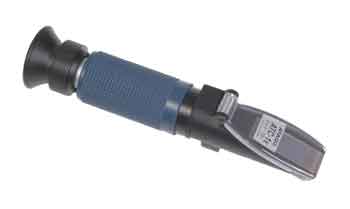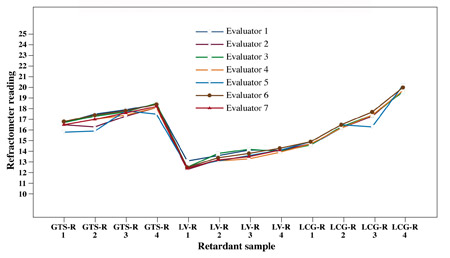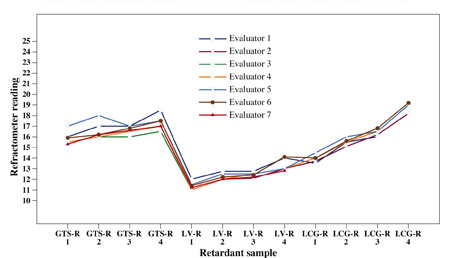Assessments
The seven refractometers were judged on their ease of use, ease of cleaning, ease of reading, and overall utility. They were compared for their accuracy and repeatability when used by the seven different evaluators. The evaluators took readings of four different concentrations of three different retardants (unthickened, low-viscosity thickened, and high-viscosity thickened retardants). Results were compared among users and also among instruments. We would expect the results from the Brix-scale refractometers to compare well with each other and the results from the arbitrary-scale refractometers to compare well with each other (accuracy). Additionally, we would expect that for any particular instrument the values obtained by different evaluators should be fairly consistent (repeatability).
The evaluators' experience in the WFCS laboratory ranged from 2 to 3 days to 15 years. Some wore glasses, some wore Assessments contact lenses, and others did not require vision correction. Because personal preferences play a large role in which refractometers users like, the aim of this evaluation is not to recommend one or two refractometers, but to discuss the advantages and disadvantages of each instrument. The Misco digital refractometer did not produce accurate or reproducible results, so the author does not recommend its purchase.
Because these instruments were tested in a laboratory, their durability in a field setting, particularly in the case of the digital refractometers, is not known.
Figure 5 compares the results from the refractometers that were assessed. Figures 6 through 12 show the different refractometers and the results of assessments by the evaluators for each of the refractometers. The captions provide additional information about the evaluators' findings.

Figure 5—This graph compares the seven refractometers that
were assessed.
The three Brix-scale refractometers have values that are clustered above
the arbitrary-scale refractometers. The Misco Digital refractometer had the
lowest values. There was some question whether this refractometer truly used
an arbitrary scale. Additionally, the shape of its line differs from the others,
raising a question about its reliability.
ATAGO ATC-1E
Figure 6—ATAGO ATC–1E: This refractometer was well liked by evaluators. The readings were accurate, as indicated by the closeness of the points measured by most evaluators (one evaluator read the results slightly high). The prism is steep. Unthickened retardant had a tendency to run off when some evaluators used this refractometer.


ATAGO Pocket Pal-1
Figure 7—ATAGO Pocket PAL-1: This refractometer received very high ratings from all evaluators. It is accurate and easy to read. Its durability in the field is unknown. It needs batteries and daily calibration (easy to do). It is easy to clean.


Bellingham & Stanley Eclipse
Figure 8—Bellingham & Stanley Eclipse: This refractometer does not have automatic temperature compensation. Readings were not as accurate (note the distance between the points measured by different evaluators). The scale was easy to read. This was the least expensive of the refractometers tested.


Leica IFT 40
Figure 9—Leica IFT 40: The “next generation” of the Reichert 10440. The scale is easy to read, but this refractometer appears to be less durable than the others evaluated. Evaluators provided little information about this model.


Misco Digital
Figure 10—Misco Digital: This refractometer was the least accurate with the least repeatable results of those assessed, as shown by the large discrepancies among evaluators. The display was easy to read, but the reading angle was awkward. Evaluators needed both hands to operate this refractometer rather than one hand, as was the case for the other refractometers that were assessed. A container of retardant had to be available in which to dip the tip of the refractometer (all others evaluated needed only a couple of drops of retardant), increasing cleanup time. This refractometer, the most expensive of those assessed, is the only one that the author would NOT recommend buying based on assessment results.


Reichert 10440
Figure 11—Reichert 10440: This model was the most difficult to read. The readings were accurate and repeatable, as indicated by the closeness of the points measured by different evaluators.


Reichert Brix 35HP
Figure 12—Reichert Brix 35HP: The clear plastic flap that covers the prism doesn’t stay up, which annoyed nearly all the evaluators. The scale was fairly easy to read. The readings were accurate and repeatable, as indicated by the closeness of the points measured by different evaluators.



